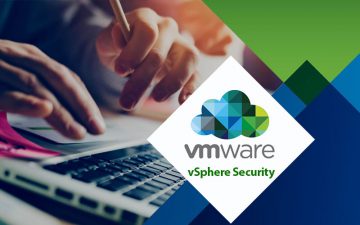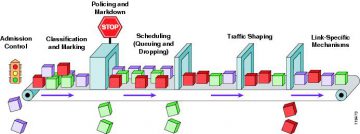مروری بر دوره
این دوره روی نصب، پیکربندی، مدیریت و تسلط بر VMware vSphere® 7.0، که شامل VMware ESXi™ 7.0 و VMware vCenter™ 7.0 می شود. این دوره محتوای پرفروش ترین VMware vSphere : نصب، پیکربندی، مدیریت دوره با قابل قیاس بودن پیشرفته و وظایف و مهارت های نظارت بر اجرای مورد نیاز برای پیکربندی محیط های در دسترس و قابل قیاس vSphere را ترکیب می کند.
دانشجویان با این مفاهیم و از طریق پایان دوره و لابراتوار های آن، تجربه عملی لازم را کسب خواهند کرد.
آنچه خواهید آموخت
- گسترش، پیکربندی، و مدیریت یک محیط زیرساخت مجازی ESXi و vCenter
- پیکربندی و مدیریت استاندارد و پیشرفته شبکه سازی ESXi و معماری فضای ذخیره سازی
- ایجاد، پیکربندی، انتقال مجازی، مدیریت و نظارت بر ماشین ها و وسایل مجازی
- مدیریت دسترسی نقش محور به زیرساخت مجازی VMware
- استفاده از سرور vCenter برای نظارت بر استفاده از منابع یک محیط و برنامه ریزی برای مقیاس بندی محیط
- پیاده سازی VMware vSphere® High Availability و VMware vSphere® Fault Tolerance برای محافظت از ماشین مجازی
- استفاده از پروفایل های هاست برای مدیریت پیکربندی ESXi و گسترش تجهیزات با مقیاس بزرگ
- استفاده از سوییچ های vSphereتوزیع شده برای مقیاس بندی شبکه
- استفاده از VMware vSphere® Storage DRS™ برای مقیاس بندی فضای ذخیره سازی
- استفاده از VMware vSphere® Update Manager™ برای به کار بردن در patch ها
- استفاده از VMware vSphere® Management Assistant برای مدیریت و نظارت بر محیط vSphere
- گسترش ESXi، vCenter Server، و VMware® vCenter Server™ Appliance™
- استفاده از VMware vSphere® ESXi™ Image Builder CLI برای ایجاد تصویر ESXi و استفاده از آن در تصویر با VMware vSphere® Auto Deploy™ برای تقسیم بندی هاست های ESXi .
سرفصل ها
Course Introduction
Introductions and course logistics
Course objectives
Describe the content of this course
Gain a complete picture of the VMware certification system
Familiarize yourself with the benefits of the VMware Education Learning Zone
Identify additional resources
resources
Introduction to vSphere and the Software-Defined Data Center
Describe the topology of a physical data center
Explain the vSphere virtual infrastructure
Define the files and components of virtual machines
Describe the benefits of using virtual machines
Explain the similarities and differences between physical architectures and virtual architectures
Define the purpose of ESXi
Define the purpose of vCenter Server
Explain the software-defined data center
Describe private, public, and hybrid clouds
Creating Virtual Machines
Introduce virtual machines, virtual machine hardware, and virtual machine files
Identify the files that make up a virtual machine
Discuss the latest virtual machine hardware and its features
Describe virtual machine CPU, memory, disk, and network resource usage
Explain the importance of VMware Tools™
Discuss PCI pass-through, Direct I/O, remote direct memory access, and NVMe
Deploy and configure virtual machines and templates
Identify the virtual machine disk format
vCenter Server
Introduce the vCenter Server architecture
Deploy and configure vCenter Server Appliance
Use vSphere Web Client
Back up and restore vCenter Server
Examine vCenter Server permissions and roles
Explain the vSphere HA architectures and features
Examine the new vSphere authentication proxy
Manage vCenter Server inventory objects and licenses
Access and navigate the new vSphere clients
· Configuring and Managing Virtual Networks
Describe, create, and manage standard switches
Configure virtual switch security and load-balancing policies
Contrast and compare vSphere distributed switches and standard switches
Describe the virtual switch connection types
Describe the new TCP/IP stack architecture
Use VLANs with standard switches
· Configuring and Managing Virtual Storage
Introduce storage protocols and storage device types
Discuss ESXi hosts using iSCSI, NFS, and Fibre Channel storage
Create and manage VMFS and NFS datastores
Describe the new features of VMFS 7.0
Introduce vSAN
Describe guest file encryption
· Virtual Machine Management
Use templates and cloning to deploy new virtual machines
Modify and manage virtual machines
Clone a virtual machine
Upgrade virtual machine hardware to version 12
Remove virtual machines from the vCenter Server inventory and datastore
Customize a new virtual machine using customization specification files
Perform vSphere vMotion and vSphere Storage vMotion migrations
Create and manage virtual machine snapshots
Create, clone, and export vApps
Introduce the types of content libraries and how to deploy and use them
· Resource Management and Monitoring
Introduce virtual CPU and memory concepts
Explain virtual memory reclamation techniques
Describe virtual machine overcommitment and resource competition
Configure and manage resource pools
Describe methods for optimizing CPU and memory usage
Use various tools to monitor resource usage
Create and use alarms to report certain conditions or events
Describe and deploy resource pools
Set reservations, limits, and shares
Describe expandable reservations
Schedule changes to resource settings
Create, clone, and export vApps
Use vCenter Server performance charts and esxtop to analyze vSphere performance
· vSphere HA, vSphere Fault Tolerance, and Protecting Data
Explain the vSphere HA architecture
Configure and manage a vSphere HA cluster
Use vSphere HA advanced parameters
Define clusterwide restart ordering capabilities
Enforce infrastructural or intra-app dependencies during failover
Describe vSphere HA heartbeat networks and datastore heartbeats
Introduce vSphere Fault Tolerance
Enable vSphere Fault Tolerance on virtual machines
Support vSphere Fault Tolerance interoperability with vSAN
Examine enhanced consolidation of vSphere Fault Tolerance virtual machines
Introduce vSphere Replication
Use vSphere Data Protection to back up and restore data
· vSphere DRS
Describe the functions and benefits of a vSphere DRS cluster
Configure and manage a vSphere DRS cluster
Work with affinity and anti-affinity rules
Describe the new capabilities for what-if analysis and proactive vSphere DRS
Highlight the evolution of vSphere DRS using predictive data from VMware vRealize® Operations Manager™
Perform preemptive actions to prepare for CPU or memory changes
Describe the vCenter Server embedded vSphere Update Manager, VMware vSphere® ESXi™ Image Builder CLI, and VMware vSphere® Auto Deploy capabilities
Use vSphere HA and vSphere DRS together for business continuity
· vSphere Update Manager
Describe the new vSphere Update Manager architecture, components, and capabilities
Use vSphere Update Manager to manage ESXi, virtual machine, and vApp patching
Install vSphere Update Manager and the vSphere Update Manager plug-in
Create patch baselines
Use host profiles to manage host configuration compliance
Scan and remediate hosts
سر فصلهای تحت پوشش از دوره Optimize and Scale [V7.0] عبارتند از:
· Network Scalability
Configure and manage vSphere distributed switches
Explain distributed switch features such as port mirroring, LACP, QoS tagging, and NetFlow
· Storage Scalability
Configure and assign virtual machine storage policies
Configure VMware vSphere® Storage DRS™ and VMware vSphere® Storage I/O Control
· Host and Management Scalability
Explain the uses of VMware vCenter® Converter™
Define and use content libraries
Describe and use host profiles
· CPU Optimization
Explain the CPU scheduler operation, NUMA support, and other features that affect CPU performance
Use esxtop to monitor key CPU performance metrics
· Memory Optimization
Explain ballooning, memory compression, and host-swapping techniques for memory reclamation when memory is overcommitted
Use esxtop to monitor key memory performance metrics
· Storage Optimization
Describe storage queue types and other factors that affect storage performance
Use esxtop to monitor key storage performance metrics
· Network Optimization
Explain the performance features of network adapters
Explain the performance features of vSphere networking
Use esxtop to monitor key network performance metrics
· Analyzing vSphere
Explain how Proactive DRS enhances virtual machine availability
· vCenter Server Availability and Performance
Describe the high availability options for vCenter Server and VMware Platform Services Controller™
Describe and use VMware vCenter Server® High Availability
Identify the factors that influence vCenter Server performance
Migrate a Windows vCenter Server 5.5 system to vCenter Server Appliance 7.0
پیش نیازها
- تجربه مدیریت سیستم در Microsoft Windows یا سیستم عامل های Linux









هنوز بررسیای ثبت نشده است.